
About the author: A student of cloud computing network operation and maintenance at school, sharing the learning experience and study notes of network operation and maintenance every day.
Motto: Keep your head down and hurry on your way, be respectful
Personal homepage: Homepage of Netdou
Table of contents
2. The composition of the IP address
Used to determine the default subnet mask of the network address A, B, and C of the IP
5. Commonly used network testing tools
foreword
This chapter will explain the concept and application of IP address in tcp/ip
1. What is an IP address

An IP address is a unique address that identifies a device on the Internet or a local network. IP stands for "Internet Protocol," which is a set of rules that govern the format of data sent over the Internet or a local network. Essentially, IP addresses are identifiers that allow information to be sent between devices on a network: they contain location information and allow devices to communicate.
- The unique identifier of the host ensures normal communication between hosts
- A network code used to identify a node in the network
- The IP address is composed of 32-bit binary (32bit), expressed in dotted decimal
2. The composition of the IP address
The ip address is composed of "network number" and "host number". Each IP address includes two identification codes (ID), namely network ID and host ID; all hosts on the same physical network use the same network ID, and a host on the network has a host ID corresponding to it.
- Network part (network)
- Host part (host)
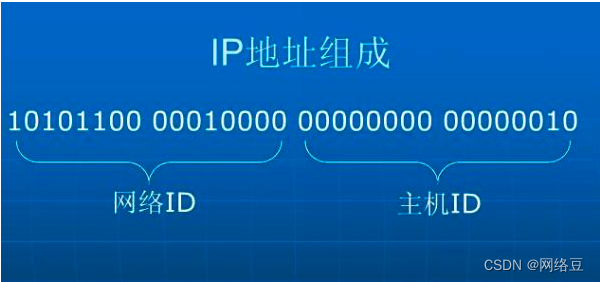
3. IP address classification
The Internet Committee has defined 5 types of IP addresses to suit networks of different capacities, namely Class A ~ Class E.

Types A, B, and C (as shown in the figure) are uniformly allocated globally by InternetNIC, and types D and E are special addresses.
Class A IP address
A Class A IP address means that among the four segments of the IP address, the first segment is the network number, and the remaining three segments are the numbers of the local computer. If the IP address is expressed in binary, the Class A IP address consists of a 1-byte network address and a 3-byte host address, and the highest bit of the network address must be "0". In class A IP addresses, the length of the network identification is 8 bits, and the length of the host identification is 24 bits. The number of class A network addresses is relatively small. There are 126 networks, and each network can accommodate more than 16 million hosts.

- Class A IP addresses range from 1.0.0.1 to 126.255.255.254
(Binary representation is: 00000001 00000000 00000000 00000001 - 01111111 11111111 11111111 11111110) The last address is the broadcast address.
Class B IP address
A Class B IP address means that among the four segments of the IP address, the first two segments are network numbers. If the IP address is expressed in binary, the Class B IP address consists of a 2-byte network address and a 2-byte host address, and the highest bit of the network address must be "10". The length of network identification in Class B IP address is 16 bits, and the length of host identification is 16 bits. Class B network address is suitable for medium-scale networks. There are 16,384 networks, and each network can accommodate more than 60,000 computers. tower.

-
Class B IP address range 128.0.0.1-191.255.255.254
(Binary representation is: 10000000 00000000 00000000 00000001----10111111 11111111 11111111 11111110) The last one is the broadcast address.
Class C IP address
A Class C IP address means that among the four segments of the IP address, the first three segments are network numbers, and the remaining segment is the number of the local computer. If the IP address is expressed in binary, the Class C IP address consists of a 3-byte network address and a 1-byte host address, and the highest bit of the network address must be "110". In class C IP addresses, the network identification length is 24 bits, and the host identification length is 8 bits. The number of class C network addresses is relatively large, with more than 2.09 million networks. Suitable for small-scale local area networks, each network can only contain up to 254 computers.

- Class C IP address range 192.0.0.1-223.255.255.254
(binary representation: 11000000 00000000 00000000 00000001 - 11011111 11111111 11111111 11111110)
Class D IP address
- Class D IP address, the first byte starts with "1110", which is a specially reserved address.
A class D IP address is historically called a multicast address, that is, a multicast address. In Ethernet, a multicast address names a group of stations on the network that should receive a packet. The highest digit of the multicast address must be "1110", and the range is from 224.0.0.0 to 239.255.255.255.
![]()
Class E IP address
The class E IP address starts with "1111", and its first byte ranges from 240 to 255, reserved for future use.
Among them, 240.0.0.0~255.255.255.254 are used as reserved addresses, and 255.255.255.255 is used as broadcast address.
![]()
- A: 1-126
- B:128-191
- C:192-223
- D:224-239
- E:240-255
A, B, C three types of address host range size
- A: 2 to the 24th power
- B: 2 to the 16th power
- C: 2 to the 8th power
What is a private address
A private IP address is an address assigned to your device by your network router. Every device on the same network is assigned a unique private IP address (sometimes called a private network address) -- this is how devices on the same internal network communicate with each other.
Private IP addresses allow devices connected to the same network to communicate with each other without being connected to the entire Internet. Private IPs help strengthen security within a particular network, such as your home or office, by making it more difficult for external hosts or users to establish a connection. That's why you can print documents to your home printer over a wireless connection, but your neighbors can't accidentally send theirs to your printer.

Private addresses meet the needs of enterprise users in the internal network Private addresses cannot be used on the Internet Private addresses include 3 groups
- Class A: 10.0.0.0-10.255.255.255
- Class B: 172.16.0.0-172.31.255.255
- Class C: 192.168.0.0-192.168.255.255
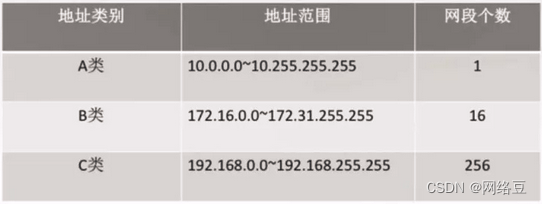
4. Subnet mask
1. What is a subnet mask
Subnet mask (subnet mask) is also called network mask , address mask , and subnet mask. It is used to indicate which bits of an IP address identify the subnet where the host is located, and which bits identify the host's bitmask. The subnet mask cannot exist alone, it must be used in conjunction with the IP address.
The subnet mask is a 32-bit address, which is used to shield a part of the IP address to distinguish the network identifier and the host identifier, and to indicate whether the IP address is on a local area network or a wide area network .

Subnet Mask Calculator
Address: Subnet Mask Calculator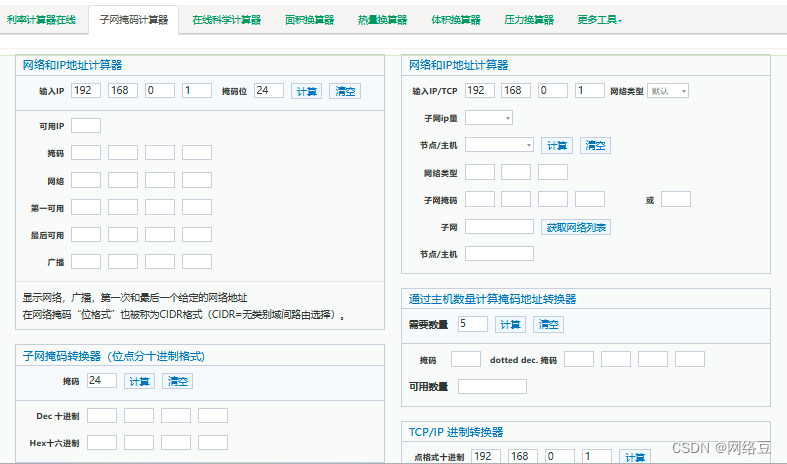
Used to determine the default subnet mask of the network address A, B, and C of the IP
- Class A: 255.0.0.0
- Class B: 255.255.0.0
- Class C: 255.255.255.0
5. Commonly used network testing tools
1. Netperf
Netperf is a network performance measurement tool, mainly for TCP or UDP -based transmission. According to different applications, Netperf can conduct network performance tests in different modes, namely bulk data transfer mode and request/response mode. Netperf test results reflect how fast one system can send data to another system, and how fast another system can receive data.
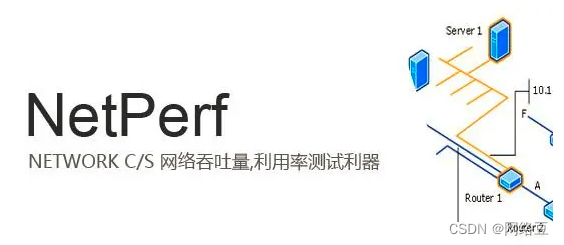
2. iperf3
iperf3 is a tool for actively measuring achievable performance on IP networks 最大带宽.
It supports tuning of various parameters related to timing, buffers and protocols (TCP, UDP, SCTP with IPv4 and IPv6). For each test, it reports bandwidth, loss, and other parameters . This is a new implementation which does not share code with the original iperf nor is it backwards compatible.

3.ping
ping (Packet Internet Groper) is an Internet packet explorer, a program used to test the amount of network connection . Ping is a service command working in the application layer of the TCP/IP network architecture . It mainly sends an ICMP (Internet Control Message Protocol Internet Message Control Protocol) Echo request message to a specific destination host to test whether the destination station is reachable and Learn about its status.

4.Tracert
Tracert ( Trace Route ) is a traceroute utility used to determine the path taken by IP packets to reach a destination. The Tracert command uses the IP time-to-live (TTL) field and ICMP error messages to determine the route from a host to other hosts on the network . The command format is as follows. tracert [-d] [-h maximum_hops] [-j computer-list] [-w timeout] target_name
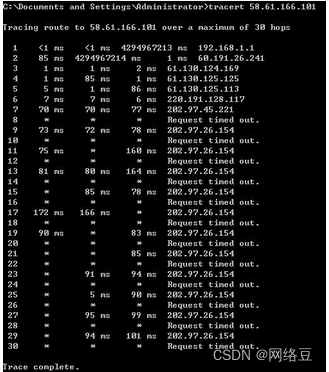
Creation is not easy, please pay attention, like, collect, thank you~